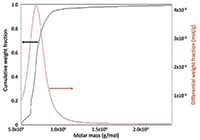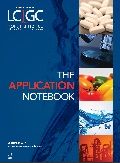Analyzing Multisegmented Block Copolymers by SEC-MALS-IV
The Application Notebook
"Click" chemistry is a class of efficient and selective reactions that is characterized by quantitative yields, tolerance to a broad range of functional groups, facile experimental set-up, and minimal synthetic work-up. This class of reactions combines particularly well with controlled radical polymerization methods, such as atom transfer radical polymerization (ATRP), and the two techniques have been prolifically employed for the synthesis of a wide variety of novel polymeric materials, including (multi) block co-polymers, stars, brushes, and gels. This note describes the analysis of multisegmented block copolymers prepared by click-coupling of block copolymers synthesized by ATRP.
Synthesis
A triblock copolymer consisting of polystyrene (PS) and poly(ethylene oxide) (PEO) was synthesized via ATRP of styrene from a difunctional PEO macroinitiator. The bromine end groups were substituted with azide by reaction with NaN3 in DMF, and the material (N3-PS-PEO-PS-N3) was coupled with propargyl ether to form a multisegmented block copolymer ((PS-PEO- PS)x).

Analysis
Due to the presence of multiple blocks within a single polymer chain, conventional size-exclusion chromatography (SEC) could not be used to accurately analyze the molecular weight of the starting materials or products. A triple detector system was employed in conjunction with SEC (TD-SEC), utilizing the following TD-SEC demonstrated that the click coupling was successful (Figure 2), and a product of higher molecular weight (Mn = 33,100 g/mol) was obtained with a broader molecular weight distribution.

Conclusion
A combination of click chemistry with ATRP was utilized to synthesize multisegmented block copolymers. Absolute molecular weight characterization via TD-SEC demonstrated a degree of polymerization of 5–7, which includes up to 21 separate blocks in a single polymer chain.
TD-SEC analysis combining multi-angle light scattering, differential viscometry and differential refractometry provides additional characterization capabilities not mentioned here, including the determination of Mark-Houwink-Sakurada coefficients as well as conformation and branching ratio.

Wyatt Technology Corporation
6330 Hollister Avenue, Santa Barbara, CA 93117
tel. (805) 681-9009, fax (805) 681-0123
Website: www.wyatt.com
















